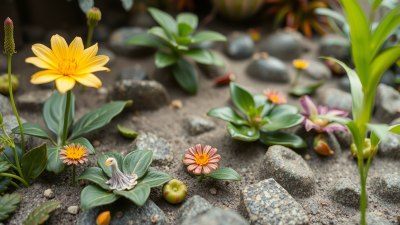Seeing the World Through Touch in a Tactile Garden in Singapore
Explore how tactile gardens enhance sensory experiences and foster connection with nature in Singapore.

In a bustling metropolis like Singapore, the Tactile Garden stands out as a unique space designed for those seeking to experience nature through touch. This innovative garden provides an alternative way to explore the natural world, especially catering to individuals with visual impairments. The sensory experience created by this representation of botanical life encourages a deeper understanding of our environment and promotes inclusivity and accessibility in public spaces.
The Tactile Garden is an initiative rooted in the belief that nature is a universal experience that should be available to everyone, regardless of physical limitations. Tactile gardens, such as the one in Singapore, are designed with specific features that engage the sense of touch, enrich the sensory palette, and allow individuals to appreciate flora in a multi-dimensional way. Touch interacts with the other senses, creating an enriching environment where participants can learn about the textures, shapes, and scents of different plants.
The Concept of a Tactile Garden
The concept of a tactile garden is grounded in the principles of inclusive design. These gardens incorporate varied textures, shapes, and sizes of plants, selected not only for their visual appeal but also for their tactile qualities. Visitors are encouraged to touch leaves, bark, flowers, and stones, each providing a unique sensory experience. This integration helps stimulate mental and emotional connections to the garden while educating visitors about plant diversity.
The Tactile Garden features winding pathways made of different materials, each inviting visitors to engage with their environment in different ways. The pathways are designed to lead visitors through a maze of sensations. They can feel the smoothness of polished stones, the roughness of tree bark, and the coolness of water features. This engagement promotes exploration and curiosity, helping visitors form a deeper bond with nature.
Guided Tours and Programs
To further enhance the experience, the Tactile Garden offers guided tours and special programs designed for groups with varying abilities. Trained guides help participants navigate through the garden, sharing informative stories about the plants while encouraging hands-on interaction. This approach fosters a sense of community among visitors and creates an environment where sharing and learning unfold naturally.
Special workshops allow participants to create tactile art, write poetry inspired by sensory experiences, and foster connections within community groups, such as schools, senior citizen homes, or organizations serving individuals with disabilities. These programs aim not only to educate but also to inspire creativity, showcasing the power of touch as a medium for artistic expression.
The Importance of Nature in Urban Spaces
Research shows that interaction with nature, even in the form of a tactile experience, can lead to improved mood, lower anxiety levels, and an overall sense of well-being. Tactile gardens also invite neurodivergent individuals to experience the world in a way that feels comfortable and engaging, making nature a sanctuary for all.
Design Elements of Tactile Gardens
The design of tactile gardens goes beyond mere aesthetics. Each garden aims to create an environment where sensory engagement reigns supreme. Elements often include raised beds, allowing for easier access to plants; varied textures, such as smooth pebbles, rough tree barks, and soft moss; and fragrant plants that enrich the olfactory experience.
Additionally, sound components are integrated into the garden, using wind chimes, water fountains, or rustling leaves to add auditory dimensions to the experience. This holistic approach to garden design encourages visitors to engage their senses fully, amplifying the connection to the natural world around them.
Community Engagement and Volunteering
The establishment of the Tactile Garden is a collaborative effort that fosters community engagement, empowering individuals to become stewards of the natural environment. Volunteers from all walks of life, including those with disabilities, contribute their time and skills to the care and maintenance of the garden. This not only reinforces a sense of ownership but also promotes inclusivity, encouraging everyone to play a role in preserving these vital natural spaces.
Community events are regularly organized, inviting families, schools, and local organizations to contribute to garden enhancement projects, such as planting new species or creating sensory experiences within the space. These collaborations are crucial in sowing seeds of environmental stewardship, cultivating a community that values accessibility and embraces the joy of nature.
Educational Impact
The Tactile Garden serves an essential educational purpose with resources available for schools interested in teaching students about horticulture, environmental science, and the importance of biodiversity. The hands-on experience encourages students to learn about the growing conditions of various plants, their habitats, and their roles in ecosystems. In addition, by integrating tactile interaction, educators can help children with different learning styles absorb information more effectively.
Students with disabilities often benefit greatly from the multi-sensory approach established in tactile gardens, making learning engaging and accessible. Field trips to the garden allow students to discover learning beyond the confines of the classroom, igniting a passion for environmental conservation and a curiosity about the natural world.
The Global Movement of Tactile Gardens
Singapore’s Tactile Garden is part of a growing global movement that recognizes the significance of sensory gardens for individuals with disabilities. Many countries are implementing tactile experiences in their public green spaces, reflecting a shift toward creating gardens that cater to diverse needs. Cities in Europe, North America, and Asia are beginning to adopt designs that integrate sensory experiences, with a focus on inclusivity and accessibility.
This worldwide trend emphasizes the potential for gardens to act as tools for social change, raising awareness of the importance of inclusive practices in public planning. By setting an example in areas that foster accessibility, communities can work together to make nature more inviting for all.
The Future of Tactile Gardens
As the world continues to evolve, so do the practices surrounding gardening and landscape design. The future of tactile gardens in Singapore holds promise as further research and feedback from the community help refine designs to better suit the needs of all visitors. There is an increasing focus on sustainability within these gardens, utilizing native plants and environmentally responsible maintenance approaches.
Moreover, technology innovations may play a role in enhancing the tactile experience for visitors. Integrating sensory technology and educational resources can improve accessibility, allowing more individuals to engage with nature on a deeper level. As tactile gardens evolve, they serve as pioneers in creating safe haven spaces that bring people together and foster connections with the natural world.
A Call to Experience
Visiting the Tactile Garden in Singapore is an invitation to reconnect with nature through touch and sensory interaction. It is a reminder that nature is not solely a visual experience; it offers various pathways for engagement. Exploration encourages a greater appreciation for the nuances of our environment and the diversity of life that surrounds us. Whether you have a disability or are a curious traveler seeking a unique adventure, the Tactile Garden welcomes everyone to step into this enriching space.
In a world increasingly dominated by technology and screens, the Tactile Garden offers a sanctuary to slow down and embrace the beauty of the natural world. Each touch, scent, and sound invites us to revel in the moment, allowing us to connect with ourselves and others as we experience the earth in a way that encourages inclusivity, education, and joy. Engage with the Tactile Garden, and discover the wonders of the world through touch, cultivating a greater understanding and appreciation for our planet.











